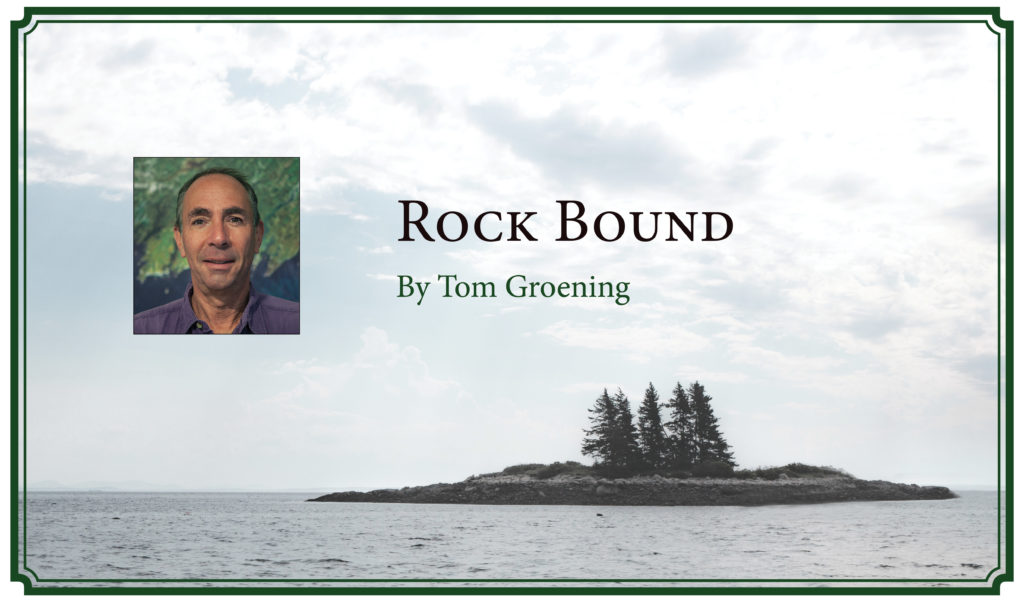By Tom Groening
I was walking to the coffee shop in Rockland last summer, weaving my way through the sidewalk full of tourists, when I saw a short, bald man in his 70s staring across the street at the marquee on The Strand, a theater that shows films and hosts musical acts. The marquee read, Juliet, Naked.
He looked perplexed, but also was staring quite intently. I couldn’t resist.
“You do realize it’s just a movie, right?” I said.
The film was about a washed-up rock star whose most famous record had been called Juliet, and a fan had stumbled across simple, unadorned acoustic versions of the now-classic songs and released them, hence the term “naked.”
He assured me he did know, but I wonder.
We began chatting, and I asked him where he was from (the San Francisco area), where he had been visiting (Mount Desert Island, then the Cushing area, if memory serves). It’s something I’ve done for years, chatting up tourists, hoping to be friendly to our visitors and also to learn something about ourselves and our state’s allure.
Maine’s eight coastal counties record more than $1.2 billion annually in taxable lodging and meals sales; tourism remains a sizable chunk of the coastal economy, and it must be nurtured.
I have written about tourism for The Working Waterfront, and during my time with the Bangor Daily News and the (Belfast) Republican Journal,for that reason. At the BDN, I would ask my editor’s permission to cover the annual governor’s tourism conference, and often found—much to my surprise—that it hadn’t been assigned to any other reporter, and often, few if any other reporters from other papers were on hand.
While at the Belfast paper, I started a summer photo feature we called “Tourist Trapped,” which had me and a photographer finding an obvious visitor near the waterfront and asking about hometown, what Maine’s lure was, and so on, just enough for a long caption. One of the things I was struck with was how many of the tourists were Mainers. They had “come down to the coast for the day,” as they put it, from Brewer, Waterville, Skowhegan.
Another watershed moment in my “talking to the tourists” saga came when the Belfast Area Chamber of Commerce asked me, as an employee of a member business, to volunteer on a Friday evening at its information center. Visitors strolled in, asking what there was to do in town, where to eat, and so on. This was pre-internet, and pre-Yelp, of course.
I remember one man who, it took me a few exchanges to realize, was looking for the cheapest seafood restaurant in town. Fine. I knew just where to send him. Others wanted an honest estimate of how long the trip would be to Bar Harbor; a stay in a Belfast motel or one in Ellsworth hung in the balance.
It was an eye-opener, seeing ourselves and our communities through their eyes. So much rides on that family vacation, and so what our towns can offer and cannot offer comes into sharp focus.
When we first arrived in Maine in the early 1980s and I was teaching at a private boarding school west of Augusta, a fellow teacher—and Munjoy Hill native—who lived just off campus on Route 17 used to brag about deliberately sending lost tourists back to I-95 via Farmington. Dumb, not funny, and self-defeating.
Three or four years ago—again on a foray to the coffee shop in Rockland—I overheard a family discussing its lunch plans and the need to find a public restroom. I inserted myself into the conversation and told them about a very fine bathroom facility the city maintains just off Main Street. A moment later, the family’s teen daughter joined the group, and Mom said to her, with me still standing by, “Oh, didn’t you have to pee, too?”
“Mom!”
Tom Groening is editor of The Working Waterfront.





